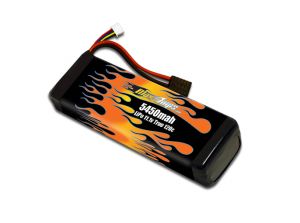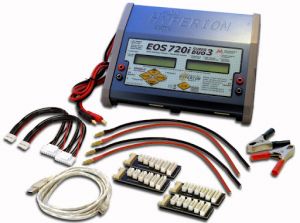Difference between revisions of "Batteries"
(More series/parallel; more on chargers; promote safety to top; travel note; general edits) |
|||
| (6 intermediate revisions by 3 users not shown) | |||
| Line 1: | Line 1: | ||
| − | + | [[File:Lipo_Battery.jpg|thumb|Lithium Polymer Battery]] | |
| − | There are too many batteries to choose from to make any meaningful list here, so we list some criteria to consider when choosing a battery. | + | Although compressed gas, hydraulics, or internal combustion engines are occasionally used (especially for weapons), batteries are used throughout combat robotics. There are too many batteries to choose from to make any meaningful list here, so we list some criteria to consider when choosing a battery. |
| − | [https://rogershobbycenter.com/lipoguide Roger's Hobby Center] has a really good guide to lipo batteries. | + | '''[https://rogershobbycenter.com/lipoguide Roger's Hobby Center]''' has a really good guide to lipo batteries. |
| − | + | <br /> | |
| − | + | == Safety == | |
| + | See the Roger's Hobby Center page for more info (link above). Rules of thumb: | ||
| − | + | * Use the right charger type (and settings) | |
| + | * Don't use parallel charging boards | ||
| + | * Charge LiPo batteries in a fire-retardant LiPo bag | ||
| + | * Discard damaged / puffy battery packs | ||
| − | + | Do not extinguish a LiPo battery fire with water; place it in sand, in a metal container, or on concrete pavement far from flammable materials. | |
| − | + | == Battery types (chemistry) == | |
| − | + | Nearly all combat robots now run on lithium polymer (LiPo) battery packs just like those used in drones and other remote-controlled devices. They have very high power density and are widely available. Unlike similar batteries in laptops, mobile phones, and other common devices, there are no charge controllers on the LiPo battery packs used (this saves weight). You will need a dedicated charger designed to monitor the charge of each cell in order to get the most out of your batteries. Nominally each cell is 3.7 volts DC, but they can be wired in series (see below) for higher voltages. | |
| − | + | Transmitters frequently use alkaline, NiMH, or lithium-based batteries. Make sure you know what your transmitter requires, and have spares on hand and ready to go during competition. | |
| + | |||
| + | == Series and parallel cells == | ||
| + | Battery packs are generally formed of more than one "cell". These are put in series or occasionally in parallel. | ||
| + | *Series cells = more volts. For example: 2 LiPo cells in series (2S) makes a 7.4V battery. Three cells (a 3S battery pack) is 11.1V. | ||
| + | *Parallel cells = more amps. Larger battery packs may have cells in both series and parallel for both higher voltage, and higher amps (current). | ||
| + | It is usually better to buy a ready made pack with the correct number and size of cells. For larger bots, however, consider physically separated, redundant battery packs for increased survivability during combat. | ||
== How much capacity do I need? == | == How much capacity do I need? == | ||
| + | Since keeping your robots weight down is always a high priority, you should only use as much battery as you need. One of the best tools for this was created by the legendary Steve Judd of Team Tentacle. His amp-hour calculator helps determine how much battery you'll need for your robot's drive system. Team Run Amok hosts a version of the '''[http://runamok.tech/RunAmok/TTT_example.html Torque and Amp-Hour calculator]''' over on their Ask Aaron site that you can use. | ||
| + | |||
| + | Don't worry if the calculator doesn't list your chosen motor. You can still get a good estimate of how much capacity you need by typing in the proper voltage, weight, wheel speed and size into the calculator. The Ask Aaron site does a good job explaining how the calculator works. Once you've figured out what you need for your drive system, you'll need to also add in the capacity you'll need for your weapon system. | ||
== Chargers == | == Chargers == | ||
| + | [[File:LipoCharger.jpg|thumb|Flexible battery charger for LiPo and other types]] | ||
| − | + | There are a lot of options for chargers. | |
| + | *Make sure your charger works for the voltage and type of your batteries; for example, the common "C6D" type charger can only charge from 2S to 4S sizes. | ||
| + | *Higher amperage batteries need more powerful chargers if rapid recharging is needed. | ||
| + | *Some chargers need external 12v power supplies (ideal for outdoor/field events when connected to a car or truck for power), while others simply plug into a power outlet. Although requiring an external power supply is inconvenient, it allows for faster charging if its capacity is high enough. | ||
| + | *Quality chargers connect to a battery's balance plug and monitor the voltages of cells in series, ensuring that one cell's voltage isn't much higher than another's. This will ensure maximum runtime for your bot and will warn you if one cell is failing. You should set aside a battery with a failing cell and not use it for competition. Poor quality chargers that don't check the voltage balance run the risk of overcharging part of the battery. | ||
| + | *Some chargers are limited to charging a single battery pack, while others can charge multiple packs at the same time. | ||
== Connectors == | == Connectors == | ||
| + | See the '''[[Connectors]]''' page to see some of the common types. Don't remove connectors from your batteries to save weight; it makes swapping and charging them challenging. Don't use any kind of reversible connector; you may start a fire if the wires are switched. | ||
| + | |||
| + | == Travel == | ||
| + | Keep LiPo batteries physically protected to avoid puncture, which can start a fire. | ||
| − | + | If traveling by air with LiPo or other Lithium-based types, read and adhere to all aircraft safety regulations concerning these types of batteries. Here is the '''[https://www.faa.gov/newsroom/lithium-batteries-baggage FAA Summary]''' for the United States. As of 2019, LiPo batteries must be hand carried aboard. You should keep them in your LiPo charging bag for safety. | |
Latest revision as of 11:48, 17 December 2023
Although compressed gas, hydraulics, or internal combustion engines are occasionally used (especially for weapons), batteries are used throughout combat robotics. There are too many batteries to choose from to make any meaningful list here, so we list some criteria to consider when choosing a battery.
Roger's Hobby Center has a really good guide to lipo batteries.
Safety
See the Roger's Hobby Center page for more info (link above). Rules of thumb:
- Use the right charger type (and settings)
- Don't use parallel charging boards
- Charge LiPo batteries in a fire-retardant LiPo bag
- Discard damaged / puffy battery packs
Do not extinguish a LiPo battery fire with water; place it in sand, in a metal container, or on concrete pavement far from flammable materials.
Battery types (chemistry)
Nearly all combat robots now run on lithium polymer (LiPo) battery packs just like those used in drones and other remote-controlled devices. They have very high power density and are widely available. Unlike similar batteries in laptops, mobile phones, and other common devices, there are no charge controllers on the LiPo battery packs used (this saves weight). You will need a dedicated charger designed to monitor the charge of each cell in order to get the most out of your batteries. Nominally each cell is 3.7 volts DC, but they can be wired in series (see below) for higher voltages.
Transmitters frequently use alkaline, NiMH, or lithium-based batteries. Make sure you know what your transmitter requires, and have spares on hand and ready to go during competition.
Series and parallel cells
Battery packs are generally formed of more than one "cell". These are put in series or occasionally in parallel.
- Series cells = more volts. For example: 2 LiPo cells in series (2S) makes a 7.4V battery. Three cells (a 3S battery pack) is 11.1V.
- Parallel cells = more amps. Larger battery packs may have cells in both series and parallel for both higher voltage, and higher amps (current).
It is usually better to buy a ready made pack with the correct number and size of cells. For larger bots, however, consider physically separated, redundant battery packs for increased survivability during combat.
How much capacity do I need?
Since keeping your robots weight down is always a high priority, you should only use as much battery as you need. One of the best tools for this was created by the legendary Steve Judd of Team Tentacle. His amp-hour calculator helps determine how much battery you'll need for your robot's drive system. Team Run Amok hosts a version of the Torque and Amp-Hour calculator over on their Ask Aaron site that you can use.
Don't worry if the calculator doesn't list your chosen motor. You can still get a good estimate of how much capacity you need by typing in the proper voltage, weight, wheel speed and size into the calculator. The Ask Aaron site does a good job explaining how the calculator works. Once you've figured out what you need for your drive system, you'll need to also add in the capacity you'll need for your weapon system.
Chargers
There are a lot of options for chargers.
- Make sure your charger works for the voltage and type of your batteries; for example, the common "C6D" type charger can only charge from 2S to 4S sizes.
- Higher amperage batteries need more powerful chargers if rapid recharging is needed.
- Some chargers need external 12v power supplies (ideal for outdoor/field events when connected to a car or truck for power), while others simply plug into a power outlet. Although requiring an external power supply is inconvenient, it allows for faster charging if its capacity is high enough.
- Quality chargers connect to a battery's balance plug and monitor the voltages of cells in series, ensuring that one cell's voltage isn't much higher than another's. This will ensure maximum runtime for your bot and will warn you if one cell is failing. You should set aside a battery with a failing cell and not use it for competition. Poor quality chargers that don't check the voltage balance run the risk of overcharging part of the battery.
- Some chargers are limited to charging a single battery pack, while others can charge multiple packs at the same time.
Connectors
See the Connectors page to see some of the common types. Don't remove connectors from your batteries to save weight; it makes swapping and charging them challenging. Don't use any kind of reversible connector; you may start a fire if the wires are switched.
Travel
Keep LiPo batteries physically protected to avoid puncture, which can start a fire.
If traveling by air with LiPo or other Lithium-based types, read and adhere to all aircraft safety regulations concerning these types of batteries. Here is the FAA Summary for the United States. As of 2019, LiPo batteries must be hand carried aboard. You should keep them in your LiPo charging bag for safety.

